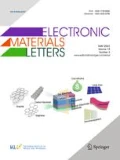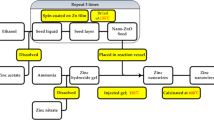Abstract
In this paper fabrication of piezoelectric ceramic–polymer composites is demonstrated via filament extrusion enabling cost-efficient large-scale production of highly bendable pressure sensors feasible for elevated temperatures. These composites are fabricated by utilizing environmentally resistant and stable liquid crystal polymer matrix with addition of lead zirconate titanate at loading levels of 30 vol%. These composites, of approximately 0.99 mm thick and length of > 50 cm, achieved excellent bendability with minimum bending radius of ~ 6.6 cm. The maximum piezoelectric coefficients d33 and g33 of the composites were > 14 pC/N and > 108 mVm/N at pressure < 10 kPa. In all cases, the piezoelectric charge coefficient (d33) of the composites decreased as a function of pressure. Also, piezoelectric coefficient (d33) further decreased in the case of increased frequency press-release cycle sand pre-stress levels by approximately 37–50%. However, the obtained results provide tools for fabricating novel piezoelectric sensors in highly efficient way for environments with elevated temperatures.
Graphical Abstract











Similar content being viewed by others
References
Wang, Xin, Jiang, Man, Zhou, Zuowan, Gou, Jihue, Hui, David: 3D printing of polymer matrix composites: a review and prospective. Compos. Part B 110, 442–458 (2017). https://doi.org/10.1016/j.compositesb.2016.11.034
Leigh, S.J., Bradley, R.J., Purssell, C.P., Billson, D.R., Hutchins, D.A.: a simple, low-cost conductive composite material for 3D printing of electronic sensors. PLoS ONE 7(11), e49365 (2012)
Isokov, D.V., Lei, Q., Castles, F., Stevens, C.J., Grovenor, C.R.M., Grant, P.S.: 3D printed anisotropic dielectric composite with meta-material features. Mater. Des. 93, 423–430 (2016). https://doi.org/10.1016/j.matdes.2015.12.176
Carriro, J.D., Traeden, N.W., Aureli, M., Leang, K.K.: Fused filament 3D printing of ionic polymer-metal composites (IPMCs). Smart Mater. Struct. 24, 125021 (2015). https://doi.org/10.1088/0964-1726/24/12/125021
Tekinalp, H.L., Kunc, V., Velez-Garcia, G.M., Duty, C.E., Love, L.J., Naskar, A.K., Blue, C.A., Ozcan, S.: Highly oriented carbon fiber-polymer composites via additive manufacturing. Compos. Sci. Technol 105, 144–150 (2014). https://doi.org/10.1016/j.compscitech.2014.10.009
Wang, Y., Castles, F., Grant, P.S.: 3D printing of NiZn ferrite/ABS magnetic composites for electromagnetic devices. Mater. Res. Soc. Symp. Proc. (2015). https://doi.org/10.1557/opl.2015.661
Castles, F., Isakov, D., Lui, A., Lei, Q., Dancer, C.E.J., Wang, Y., Januruding, J.M., Speller, S.C., Grovenor, C.R.M., Grant, P.S.: Microwave dielectric characterization of 3D-printed BaTiO3/ABS polymer composites. Sci. Rep. 6, 22714 (2016). https://doi.org/10.1038/srep22714
Castro, J., Rojas, E., Ross, A., Weller, T., Wang, J.: High-k and low-loss thermoplastic composites for fused deposition modeling and their application to 3D-Printed Ku-band antennas, microwave symposium. IEEE MTT-S Int (2016). https://doi.org/10.1109/MWSYM.2016.7540068
Ferreira, A., Ferreira, F., Paiva, C.: Textile sensor applications with composite monofilaments or polymer/carbon nanotubes. Adv. Sci. Technol. 80, 65–70 (2012). https://doi.org/10.4028/www.scientific.net/AST.80.65
Matsuzaki, R., Ueda, M., Namiki, M., Jeong, T.-K., Asahara, H., Horiguchi, K., Nakamura, T., Todoroki, A., Hirona, Y.: Three-dimensional printing of continuous-fiber composites by in-nozzle impregnation. Sci. Rep. 6, 23058 (2016). https://doi.org/10.1038/srep23058
Kim, Kanguk, Zhu, Wei, Xin, Qu, Aaronson, Chase, McCall, William R., Chen, Shaochen, Sirbuly, Donald J.: 3D optical printing of piezoelectric nanoparticle—polymer composite materials. ACS Nano 8(10), 9799–9806 (2014). https://doi.org/10.1021/nn503268f
Jain, A., Prashanth, K.J., Sharma, A.K., Jain, A., Rashmi, P.N.: Dielectric and piezoelectric properties of PVDF/PZT Composites: a review. Polym. Eng. Sci. 55(7), 1589–1616 (2015). https://doi.org/10.1002/pen.24088/
Volkan, K., Ibrahim, Ç., Timucin, M.: Dielectric and piezoelectric properties of PZT ceramics doped with strontium and lanthanum. Ceram. Int. 37(4), 1265–1275 (2011). https://doi.org/10.1016/j.ceramint.2010.12.003
Kechiche, M.B., Bauer, F., Harzallah, O., Drean, J.-Y.: Development of piezoelectric coaxial filament sensors P(VDF-TrFE)/copper for textile structure instrumentation. Sens. Actuators A 204, 124–130 (2013). https://doi.org/10.1016/j.sna.2013.10.007
Martins, R.S., Goncalves, R., Azevedo, T., Rocha, J.G., Nóbrega, J.M., Carvalho, H., Lanceros-Mendez, S.: Piezoelectric coaxial filament produced by coextrusion of poly(vinylidene fluoride) and electrically conductive inner and outer layers. J. Appl. Polym. Sci. (2014). https://doi.org/10.1002/app.40710
Bayramol, D.V.: Effects of tourmaline on the voltage response of PVDF filaments. Ind. Text. 68, 47–53 (2017)
Porter, D., Hoang, T., Berfield, T.: Effects of in situ poling and process parameters on fused filament fabrication printed PVDF sheet mechanical and electrical properties. Addit. Manuf. 13, 81–92 (2017)
Ferroperm: High Quality Components and Materials for the Electronic Industry. http://www.ferroperm-piezo.com/files/files/Ferroperm%20Catalogue.pdf
Elmore, T.: Instruction and Assembly Manual for Filastruder. http://www.soliforum.com/topic/2036/filastruder-documentation-and-cadstl-files/
Tolvanen, J., Hannu, J., Nelo, M., Juuti, J., Jantunen, H.: Dielectric properties of novel polyurethane-PZT-graphite foam composites. Smart Mater. Struct. 25, 095039 (2016)
Sharma, N.D., Maranganti, R., Sharma, P.: On the possibility of piezoelectric nanocomposites without using piezoelectric materials. J. Mech. Phys. Solids 55(11), 2328–2350 (2007). https://doi.org/10.1016/j.jmps.2007.03.016
Chu, B., Salem, D.R.: Flexoelectricity in several thermoplastic and thermosetting polymers. Appl. Phys. Lett. 101, 103905 (2012). https://doi.org/10.1063/1.4750064
Jaitanong, N., Yimnirun, R., Zeng, H.R., Li, G.R., Yin, Q.R., Chaipanich, A.: Piezoelectric properties of cement based PVDF/PZT composites. Mater. Lett. 130, 146–149 (2014)
Li, Z., Gong, H., Zhang, Y.: Fabrication and piezoelectricity of 0-3 cement based composite with nano-PZT powder. Curr. Appl. Phys. 9, 588–591 (2009)
Chaipanich, A.: Effect of PZT particle size on dielectric and piezoelectric properties of PZT-cement composites. Curr. Appl. Phys. 7, 574–577 (2007)
Guan, X., Zhang, Y., Li, H., Ou, J.: PZT/PVDF composites doped with carbon nanotubes. Sens. Actuator A-Phys. 194, 228–231 (2013)
Babu, I., de With, G.: Highly flexible piezoelectric 0-3 PZT-PDMS composites with high filler content. Compos. Sci. Technol. 91, 91–97 (2014)
Kirkpatrick, M., Tarbutton, J., Le, T., Lee, C.: Characterization of 3D printed piezoelectric sensors: determination of d33 piezoelectric coefficient for 3D printed polyvinylidene fluoride sensors. Sensors (2016). https://doi.org/10.1109/ICSENS.2016.7808876
Acknowledgements
Financial support of the Hybrid materials project (2105/31/2013) of Tekes program of the Finnish Metals and Engineering Competence Cluster (FIMECC Ltd) is gratefully acknowledged. Author J.J. acknowledges the funding of the Academy of Finland (project numbers 267573). Author JT was supported by Riitta and Jorma J. Takanen Foundation, Walter Ahlström Foundation, Tauno Tönning Foundation, and Finnish Foundation for Technology Promotion. Also, authors would like to acknowledgment Dr. Maciej Sobocinski for introducing the filament extruding technique and Dr. Mikko Nelo for helping to find possible solutions to fabricate filaments with higher PZT loadings.
Author information
Authors and Affiliations
Corresponding author
Rights and permissions
About this article
Cite this article
Tolvanen, J., Hannu, J., Juuti, J. et al. Piezoelectric Flexible LCP–PZT Composites for Sensor Applications at Elevated Temperatures. Electron. Mater. Lett. 14, 113–123 (2018). https://doi.org/10.1007/s13391-018-0027-0
Received:
Accepted:
Published:
Issue Date:
DOI: https://doi.org/10.1007/s13391-018-0027-0




